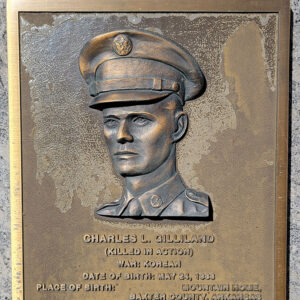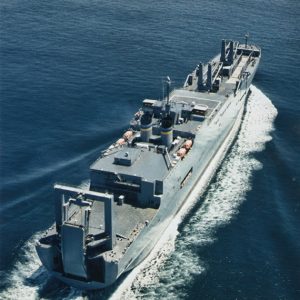calsfoundation@cals.org
USNS Gilliland (T-AKR-298)
The USNS Gilliland is a Gordon-class large, medium-speed, roll-on/roll-off (LMSR) ship originally built as a Danish cargo ship before being modified to join the U.S. Military Sealift Command. The vessel is named for Charles Gilliland of Yellville (Marion County), who earned a posthumous Medal of Honor for valor during the Korean War.
Charles Leon Gilliland joined the U.S. Army on his seventeenth birthday in 1950, just two months before the Korean War began. He was serving with Company I of the Seventh Infantry Regiment when his company position was attacked near Tongmang-ni, Korea, on April 25, 1951. Gilliland held the main attack at bay with his automatic rifle and, though wounded, volunteered to stay behind and cover his fellow soldiers’ retreat. His body was never recovered, but he was declared dead in 1954 and awarded the Medal of Honor.
The ship that would be named in Gilliland’s honor began its career as the Selandia. The vessel was built by Burmeister & Wain in Yard No. 845 in Copenhagen, Denmark, and completed on September 18, 1972. With its three propellers powered by one 26,000-hp and two 39,000-hp diesel engines, the Selandia and its sister ship Jutlandia worked the Europe-Far East trade route and were considered the fastest cargo ships in the world. The Selandia was lengthened by Hyundai in 1984.
In the early 1990s, the U.S. Joint Chiefs of Staff conducted a study that concluded that the military needed expanded sealift capabilities to meet wartime and national emergency needs. The Military Sealift Command (MSC) was created, combining a fleet of tankers and dry cargo ships along with “surge” vessels to be used in times of crisis.
The navy acquired both the Selandia and the Jutlandia (which would become the USNS Gordon) in the early 1990s to convert them into “surge” LMSRs, ready to go into action within ninety-six hours of being mobilized. While harbored at a pier at Newport News, Virginia, in June 1996, the Selandia broke loose from its moorings amid forty-mile-per-hour winds and drifted into the destroyer USS Deyo; no damage report to either vessel appears to exist. The Newport News Shipbuilding and Drydock Company won a contract on May 23, 1997, to update the Selandia. On May 24, 1997, which would have been Charles Gilliland’s sixty-fourth birthday, the Danish ship was christened the USNS Gilliland.
The Gilliland is 954 feet long and 106 feet wide, with a 284,064-square-foot hold that with a 49,991-square-foot cargo deck can carry a 55,450-ton load. With a thirty-six-foot draft, the Gilliland can achieve speeds of twenty-four knots, manned by twenty-six to forty-five civilian sailors and up to fifty U.S. Navy personnel. The USNS Gilliland is attached to the MSC Atlantic surge force, maintained in a four-day readiness status.
For additional information:
“Large, Medium-Speed, Roll-On/Roll-Off Ships T-AKR.” United States Navy Fact File. https://www.navy.mil/navydata/fact_display.asp?cid=4600&tid=500&ct=4 (accessed July 17, 2020).
“Military Sealift Command (MSC) Sealift Ships Index.” NavSource.org. http://www.navsource.org/archives/09/84idx.htm (accessed July 17, 2020).
“Ships of the East Asiatic Line, 1970–1979.” Mariners. http://www.mariners-l.co.uk/eac/eac1970-1979.htm (accessed July 17, 2020).
Mark K. Christ
Central Arkansas Library System
 Divergent Prosperity and the Arc of Reform, 1968–2022
Divergent Prosperity and the Arc of Reform, 1968–2022 Military
Military Charles L. Gilliland Plaque
Charles L. Gilliland Plaque  USNS Gilliland
USNS Gilliland 




Comments
No comments on this entry yet.